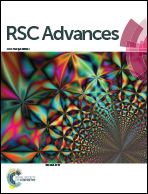Biodemulsifiers produced by Achromobacter sp. and their features in improving the biodegradation of phenanthrene†
Abstract
The application of biodemulsifiers plays an essential role in oil recovery and demulsification. However, little is known about their features during the biodegradation of petroleum hydrocarbons. In the present study, a demulsifying strain of Achromobacter sp. LH-1 was applied for the degradation of petroleum hydrocarbons and the effects of the biodemulsifiers produced by LH-1 during the degradation process were investigated. Several common petroleum hydrocarbons, including aromatic and aliphatic compounds, were utilized by strain LH-1 as the sole carbon source for the production of biodemulsifiers. Taking phenanthrene (PHE) as the sole carbon source with an initial concentration of 100 mg L−1, the optimal cultivation conditions were determined using response surface methodology based on a Box–Behnken design to further enhance demulsification efficiency. The results showed that LH-1 could secret lipopeptide extracellular biodemulsifiers and achieved 95.6% demulsification efficiency for water-in-oil model emulsions within 24 h and 92.3% PHE degradation efficiency within five days. It demonstrated that biodemulsifier-induced dissolution played the dominant role in PHE degradation and thus, the excellent PHE degradation capability of LH-1 is closely related to biodemulsifier production.


 Please wait while we load your content...
Please wait while we load your content...